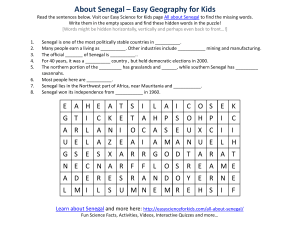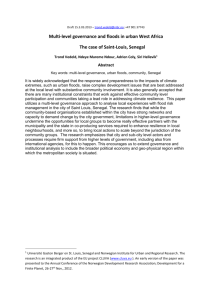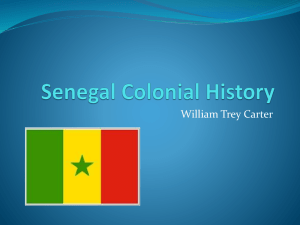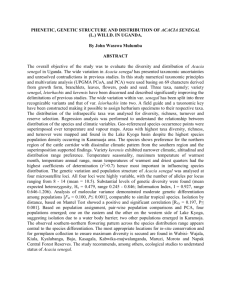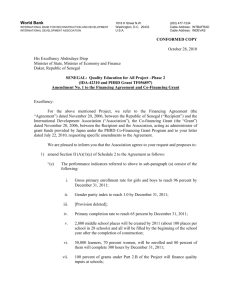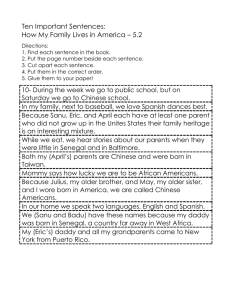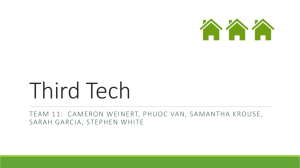Science Journal of Sociology and Anthropology ISSN:2276-6359
advertisement
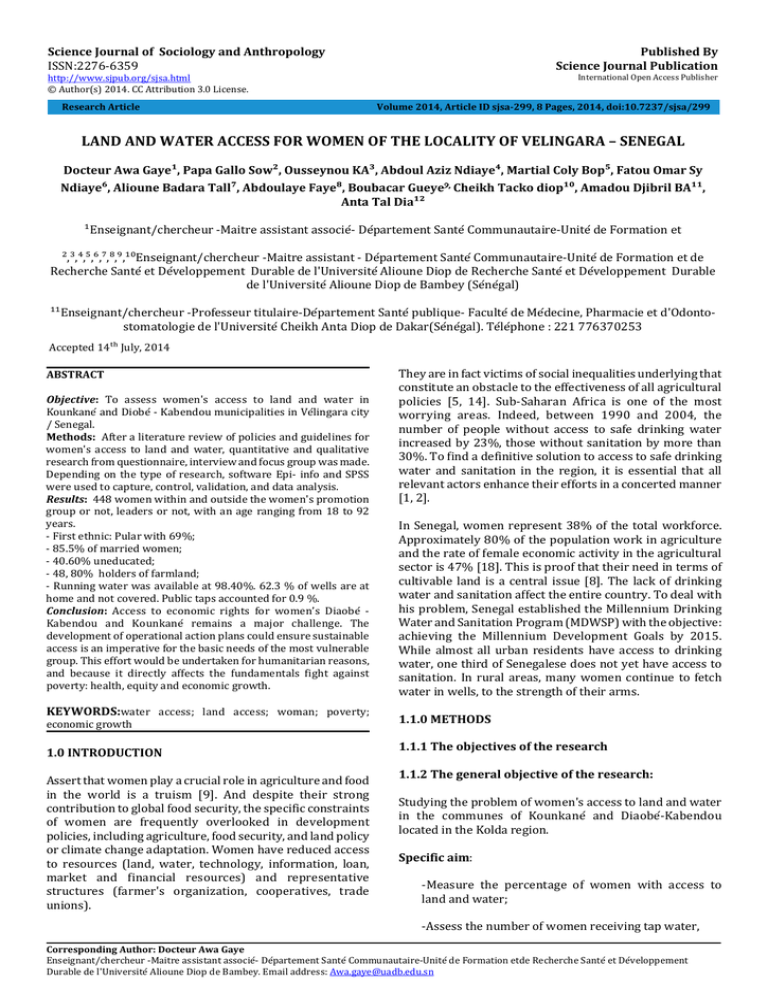
Published By Science Journal Publication Science Journal of Sociology and Anthropology ISSN:2276-6359 International Open Access Publisher http://www.sjpub.org/sjsa.html © Author(s) 2014. CC Attribution 3.0 License. Research Article Volume 2014, Article ID sjsa-299, 8 Pages, 2014, doi:10.7237/sjsa/299 LAND AND WATER ACCESS FOR WOMEN OF THE LOCALITY OF VELINGARA – SENEGAL Docteur Awa Gaye¹, Papa Gallo Sow², Ousseynou KA³, Abdoul Aziz Ndiaye⁴, Martial Coly Bop⁵, Fatou Omar Sy Ndiaye⁶, Alioune Badara Tall⁷, Abdoulaye Faye⁸, Boubacar Gueye Cheikh Tacko diop¹⁰, Amadou Djibril BA¹¹, Anta Tal Dia¹² ¹Enseignant/chercheur ‑Maitre assistant associé‑ Département Santé Communautaire‑Unité de Formation et ²,³,⁴,⁵,⁶,⁷,⁸,⁹,¹⁰Enseignant/chercheur ‑Maitre assistant ‑ Département Santé Communautaire‑Unité de Formation et de Recherche Santé et Développement Durable de l'Université Alioune Diop de Recherche Santé et Développement Durable de l'Université Alioune Diop de Bambey (Sénégal) ¹¹Enseignant/chercheur ‑Professeur titulaire‑Département Santé publique‑ Faculté de Médecine, Pharmacie et d'Odonto‑ stomatologie de l'Université Cheikh Anta Diop de Dakar(Sénégal). Téléphone : 221 776370253 Accepted 14�� July, 2014 ABSTRACT Objective: To assess women's access to land and water in Kounkané and Diobé ‑ Kabendou municipalities in Vélingara city / Senegal. Methods: After a literature review of policies and guidelines for women's access to land and water, quantitative and qualitative research from questionnaire, interview and focus group was made. Depending on the type of research, software Epi- info and SPSS were used to capture, control, validation, and data analysis. Results: 448 women within and outside the women's promotion group or not, leaders or not, with an age ranging from 18 to 92 years. - First ethnic: Pular with 69%; - 85.5% of married women; - 40.60% uneducated; - 48, 80% holders of farmland; - Running water was available at 98.40%. 62.3 % of wells are at home and not covered. Public taps accounted for 0.9 %. Conclusion: Access to economic rights for women’s Diaobé ‑ Kabendou and Kounkané remains a major challenge. The development of operational action plans could ensure sustainable access is an imperative for the basic needs of the most vulnerable group. This effort would be undertaken for humanitarian reasons, and because it directly affects the fundamentals fight against poverty: health, equity and economic growth. KEYWORDS:water access; land access; woman; poverty; economic growth 1.0 INTRODUCTION Assert that women play a crucial role in agriculture and food in the world is a truism [9]. And despite their strong contribution to global food security, the specific constraints of women are frequently overlooked in development policies, including agriculture, food security, and land policy or climate change adaptation. Women have reduced access to resources (land, water, technology, information, loan, market and financial resources) and representative structures (farmer's organization, cooperatives, trade unions). They are in fact victims of social inequalities underlying that constitute an obstacle to the effectiveness of all agricultural policies [5, 14]. Sub-Saharan Africa is one of the most worrying areas. Indeed, between 1990 and 2004, the number of people without access to safe drinking water increased by 23%, those without sanitation by more than 30%. To find a definitive solution to access to safe drinking water and sanitation in the region, it is essential that all relevant actors enhance their efforts in a concerted manner [1, 2]. In Senegal, women represent 38% of the total workforce. Approximately 80% of the population work in agriculture and the rate of female economic activity in the agricultural sector is 47% [18]. This is proof that their need in terms of cultivable land is a central issue [8]. The lack of drinking water and sanitation affect the entire country. To deal with his problem, Senegal established the Millennium Drinking Water and Sanitation Program (MDWSP) with the objective: achieving the Millennium Development Goals by 2015. While almost all urban residents have access to drinking water, one third of Senegalese does not yet have access to sanitation. In rural areas, many women continue to fetch water in wells, to the strength of their arms. 1.1.0 METHODS 1.1.1 The objectives of the research 1.1.2 The general objective of the research: Studying the problem of women's access to land and water in the communes of Kounkané and Diaobé‑Kabendou located in the Kolda region. Specific aim: -Measure the percentage of women with access to land and water; -Assess the number of women receiving tap water, Corresponding Author: Docteur Awa Gaye Enseignant/chercheur ‑Maitre assistant associé‑ Département Santé Communautaire‑Unité de Formation etde Recherche Santé et Développement Durable de l'Université Alioune Diop de Bambey. Email address: Awa.gaye@uadb.edu.sn Science Journal of Sociology and Anthropology( ISSN:2276-6359) -Evaluate the proportion of women satisfied acquired with farmland. 1.2.0 Methodology The general approach is based on a collecting data that took place in the second half of June 2013. It was preceded through the training of investigators, testing tools, the sensitization of the authorities, and communities on the interest of research. page 2 - Being unable to respond freely to questions. Qualitative research had targeted women and men in certain neighborhoods. It was: - Women belonging to Groups Policies Female; - Groupings of non Policies Female women; , - Men opinion leaders. From a sampling inspired by the survey methodology of the WHO, the study appealed data collection tools such as the technique of documentary, a survey, maintenance guides and a VCR for focus groups. A total of 450 women were interviewed and 02 incomplete questionnaires were eliminated. No refusal has been reported. The analysis focused on 448 questionnaires. 1.2.2 Sampling We were inspired by the sampling method used by WHO as part of the assessment of immunization coverage. It was initially to determine the number of clusters, and then divide between the two strata (Kounkané and Diaobé ‑ Kabendou) for the two cities; a number N of women will be questioned. The study involved three components: 1.2.2.1 - Sample Size -A literature review to take stock of policies and guidelines for land and water access for women. An exhaustive census was conducted to determine the status of guidelines and standards he policies for access to land and water; -A quantitative study, from discussion and questionnaire to estimate the level of the f o l l o w i n g indicators among women from the two communes: - % of women with access to land and water; - % of source of tap water supplies. -A Qualitative research in the form of focus groups in some areas covered by the quantitative study. This facilitated the understanding and the combination of two types of data. This approach allowed us to analyze the perception and popular representations regarding women's access to land and water. These studies have focused: first, on the entire adult women of the two communes with criteria for inclusion and exclusion of well defined; then on women and men in certain areas belonging to GPF, the non GPF women and men (opinion leaders or not) 1.2.1 The study population For the quantitative study, the choice of the people s' was based on criteria of inclusion and non-inclusion : Inclusion criteria: - Women aged 18 years or older residing in one of the targeted communes ; The following equation was used to calculate the sample size. N=Z*P*(1-P) i² • Z is the confidence level; • p is the initial level.... (50 %); • i is the margin of error. N = [ 1.96 ² x 0.50 (1-0,50) / 0.05 ²] = 384 This corresponds to 384 women , rounded to 400; 40 clusters of 10. So a minimum of 400 must be seen with women leaders and spouses, a sample of 450 people were surveyed. 1.2.2.2 - Selection method of statistical units A draw at two levels has been achieved. First, a stratified sampling to determine the number of clusters assigned to each county. Then at each stratum, the cumulative effective method allowed the distribution of clusters among neighborhoods. The concession will be the sampling unit. In each area, depending on number of clusters, one or more sociological centers have been identified for the draw and the first choice of concession to visit. Then, the step by step progression was used to select other concessions to visit. In each concession, all households were visited and a woman in each household selected at random will be questioned. In each cluster at least 10 women were surveyed. For married women, their spouses were also. For the focus group, eight groups were formed; 4 women and 4 men. In each focus group there were 10 participants. Each group of participants came from a village in the resort, chosen at random. 1.2.3 - Data Analysis - Secondarily married man living in one of the common; - Being present the survey period . 450 women were interviewed and 02 incomplete questionnaires were eliminated. The analysis focused on 448 questionnaires. Non-inclusion criteria: - Refusal to participate in the survey; For the quantitative survey, Epi- info software was used for data entry. After validation and control of the database, analysis was performed with SPSS software. Chi-square test How to Cite this Article: Docteur Awa Gaye, Papa Gallo Sow, Ousseynou KA, Abdoul Aziz Ndiaye, Martial Coly Bop, Fatou Omar Sy Ndiaye, Alioune Badara Tall, Abdoulaye Faye, Boubacar Gueye, Cheikh Tacko diop, Amadou Djibril BA, Anta Tal Dia, "Land and Water Access for Women of the Locality of Velingara – Senegal" Volume 2014, Article ID sjsa-299, 8 Pages, 2014, doi:10.7237/sjsa/299 Page 4 will be used to compare proportions with a risk of error of 5 %. Finally, triangulation was performed for further analysis combining the different results. Collection tools: the technical literature, a survey questionnaire; maintenance guides and VCR for focus groups Science Journal of Sociology and Anthropology( ISSN:2276-6359) interviewed are often married (8 in 10 women). Education is still a problem in this area: 4 in 10 women have no education, 2 out of 10 said that they had no formal instruction. About 3 in 10 women are enrolled in school while only 10 reached the secondary level. Literacy concerned only few women around only 1 in 20 women. Women are exceptionally householder, 3 out of 10 are housewives. 1.2.4 Ethical Aspects Protocol was submitted to the National Ethics Committee by Senegal Word vision that allowed him to have the authorization of the Ministry of Health informing the administrative authorities and local communities in the study. Free and informed consent of the participants was a prerequisite to starting the data collection. In case of health problems, the participant was oriented to the structure of the nearest health facility for care. 2.0 RESULTS 2.1.0 Sociodemographic characteristics of the sample The poorest region of Senegal, Kolda, is located south-east of the country. Following the administrative division of 2008 and Kounkané Diaobé‑Kabendou of Vélingara were erected in public. They respectively comprise approximately 17,000 and 30,000 inhabitants. In our work sample, the dominant religion was Islam; almost seven out of 10 women surveyed were pullars. The women interviewed were mostly married (eight out of 10 women). Age could not be determined accurately for 338 respondents. It ranged between 18 and 92 years with an average of 31.4. The median was 30 years, 23 years in the first quartile and the 3rd in 38 years. Women of childbearing age accounted for 93.8% of respondents (Table I). 2.1.1 Women's access to land and water In terms of economic power, 48.80 % of women were farmland. However, only 35.5% of them were satisfied with the size of their land. They were said to have acquired farmland mainly from their husbands (45.40%) and inheritance (23.6 %). Occupations of women were generally small trade (44.4 %) and household activities (29.5 %). Running water was available to the majority of the population (98.40%) with 62.3% of wells home open. Public taps accounted for only 0.9 % (Table II). 3.0 DISCUSSIONS Women's occupations are generally small trade (44.4%) and domestic activities (29.5%). Some women reported having agriculture as their main occupation. 3.1.2 - Women's access to land and water Access to land is a strong economic indicator in rural areas. Women said acquire farmland mainly from their husbands (45.40%), by inheritance (23.6%) and rarely by renting. But only one third of these is satisfied with their area (Table II). The system of land management is based on tradition and customs. In almost all ethnic groups, small plots in concessions are reserved for women for vegetable crops. Before marriage, the girl grows with his mother, on her mother's plot. She has no cultivation right contrary to young men. In cities, the situation is different; woman can buy, lease land, buy or build a house if she has the means. The system of land management is based on tradition and customs. In almost all ethnic groups, small plots enclosed in grants are reserved for women for vegetable crops. Before marriage, the girl cultivated with his mother, on the plot of it. She has no right culture unlike young men. In the city, the situation is different. A woman can buy, lease land, buy or build a house or exploitation if she has the means. The earth is not traditionally part of shared property upon death of a family head. The family land area is divided at the time of emancipation of a household who composed [11]. Almost all interviewed (98%) have access to piped water. The supply is mainly at wells. Opened wells at home (62%) are followed by closed wells at home (18.1%) and public opened wells (10.7%). Other sources such as taps at home (3.1%) and public taps (0.9%) are less numerous. The water is thus free to almost the entire population (90%). Taps hardly exist in homes, except in a few houses of immigrants. Thus water from wells, which drinkability is doubtful, is used as drinking water, since there are no other alternatives. However, some participants said put a few drops of bleach to make it drinkable. The urgency of a drilling access to drinking water for the entire community was emphasized. Note that the majority of participants raised issues: 3.1.0 Analysis of field data - The weakness of the extension of the water network; 3.1.1 Socials characteristics of the sample - Most of the traditional wells were infested or sagged; Nearly 7 in 10 women surveyed are pullars. Women - The lack of hydrants with a bad taste of the water; How to Cite this Article: Docteur Awa Gaye, Papa Gallo Sow, Ousseynou KA, Abdoul Aziz Ndiaye, Martial Coly Bop, Fatou Omar Sy Ndiaye, Alioune Badara Tall, Abdoulaye Faye, Boubacar Gueye, Cheikh Tacko diop, Amadou Djibril BA, Anta Tal Dia, "Land and Water Access for Women of the Locality of Velingara – Senegal" Volume 2014, Article ID sjsa-299, 8 Pages, 2014, doi:10.7237/sjsa/299 Science Journal of Sociology and Anthropology( ISSN:2276-6359) - Non-functionality of most fountains; - Related to the high cost of connecting and m³ of water. 3.1.3- Priorities for future action page 4 - In the Land Law, the land is divided into three units, each with its own system: private property, public property and rural land [11]. The transversality women's issues require the establishment, namely: - An office Charge independent halls; 3.1.3.1-At the constitutional level Strictly enforce the laws contained in the Constitution, adopted by referendum on January 7, 2001[17]. Indeed: of Women conditions, -The capacity building of the Ministry of Women and Family, to enable it to ensure coordination, monitoring and evaluation of national equity and equality strategy in these two localities; -the preamble of the constitution reminds the respect for individual freedom and human rights; respect for cultural specificities, respect for fundamental freedoms, access of all citizens, without discrimination, in the exercise of power at all levels, rejection and elimination, in all forms of injustice, inequality and discrimination; -A transversal structure "Woman" in all ministries for better coordination and monitoring and evaluation of actions in favor of women; - An observatory for gender equality especially in the region of Kolda or in the department of Vélingara. - Article 8 guarantees to all citizens the fundamental individual freedoms, economic and social as well as collective rights, including the right to property; - Article 15 states that "The man and woman also have the right to access the possession and ownership of the land under the conditions determined by law", implying that the customary restrictions on women's access to land is prohibited. The woman sees and devoted his right to land [8]; Fight against customary norms, religious beliefs and social practices affecting land rights differentiated by gender. In town, the family code that determines the land rights of women. In rural areas, it is the custom that is decisive. The woman is under the authority of his father as a young girl and then under that of her husband. Widows are expected to marry the brother of the deceased husband or remain under the authority of the son. According to tradition, the earth and the children belong the family of the husband and wife does not inherit. - Article 17 commits the State to ensure that families in general and especially those living in rural areas, including women, the right to relief their living conditions and access to health and welfare [13]; - Article 19 states that "Every woman has the right to have her own heritage as the husband. She has the right to personal management of his property. 3.1.3.2 - Institutional standpoint -Enforce the rights of women on the heritage and land use contained in the Civil Code[12], the Labor Code [6] and the Family Code [10]; 3.1.3.3-Legal standpoint The law on national land estate makes no explicit discrimination between man and woman but single women do not have direct access to cultivated land. Despite legislative, communal and Muslim forecasts, rural women do not inherit: it is the custom. 3.1.3-4 At the economic level It is proposed to: -Enforce the Land Law [11], especially: -Strengthen organizational, financial and administrative management capacities of women; - Law n ° 64-46 of the land of 17 June 1964 on the National Estate; Decree of application No. 64-573 of 30 July 1964; -Facilitate women's access to loan; - According to the above provisions, rural communities manage the land of the community, including the natural resources that are not part of the protected areas. The powers of local a u t h o r i t i e s regarding land are not within the control. They are performed under the supervision of decentralized authorities of the State [7]; - The law on the national domain is neutral in terms of equality between men / women with regard to land [16]; -train women in the fields of agricultural and / or pastoral techniques; -Implement a literacy program for women; -facilitate the obtaining of legal recognition to women. 3.1.3.5-At the political level Encourage measures promoting the application of the rights of women to access land through the following actions: - Strengthen the Ministry of Women, Family and Social Development, in charge of gender issues; How to Cite this Article: Docteur Awa Gaye, Papa Gallo Sow, Ousseynou KA, Abdoul Aziz Ndiaye, Martial Coly Bop, Fatou Omar Sy Ndiaye, Alioune Badara Tall, Abdoulaye Faye, Boubacar Gueye, Cheikh Tacko diop, Amadou Djibril BA, Anta Tal Dia, "Land and Water Access for Women of the Locality of Velingara – Senegal" Volume 2014, Article ID sjsa-299, 8 Pages, 2014, doi:10.7237/sjsa/299 Page 5 Science Journal of Sociology and Anthropology( ISSN:2276-6359) - Validate the National Strategy for Equality and Gender Equity (SNEEG) for the period 2005-2015[16]; - Association of Women Jurists in Senegal (AJS). - Establish a National Advisory Committee on Women; IV- Recommendations/Perspectives for future action - Involve Rural and Agricultural Organizations in the Land Commission; Women’s - Make visible and legitimate federations and women's organizations; - Fight against the lack of legal information; - Promote the empowerment of women in the legal process to become landowner; - Fight against the saturation of agricultural land; - Fight against land degradation. 3.1.3-6 - In the media It will require strengthen the prerogatives of national and local institutions that apply the regulations relating to land: the State and its decentralized structures: rural councils, rural communities, traditional authorities [11]. At rural councils, the majority of land allocation requests usually men. This is often due to the traditional system in place, the lack of information on the procedures and / or an ignorance of rights by women. In local making bodies (regional councils, municipal councils, rural councils, chiefdoms village, and neighborhood chiefs) women's representation will have to be reinvigorate. Implement legal information and strengthen the capacities of women's land rights and access to water through: It comes to: ● The organization of tours by the civil society; - Increase programs promoting the role of women in society; ● Advocacy actions by the Ministry of Women, Family and Social Development in the direction of mayors and presidents of rural communities for the real application of provisions of the Constitution relating to women's access to land and water; - Develop community radio; - Involve women in all programs, regardless of the domain and subject. ● The organization of reflective and advocacy workshops on "land, water and Gender" question. 3.1.3-7 - As regards research It’s necessary to: - Promote research, encourage field surveys on women's issues, particularly on issues that are considered taboo by society, such as the inheritance rights of women, sharing responsibilities with men in water and land. - Carry out technical studies for the configuration of the drinking water supply system. - Conduct technical studies to establish baseline in land matters. 3.1.3-8-At the level of civil society Support the civil society and indigenous peoples working for equal rights to land in particular: - National Network of Rural Women in Senegal (RNFRS): structure of civil society established in May 1992; - National Union for Valuing Women's Activities Network (CVNVAF); The Government of Senegal and international agencies must recognize the important role of women in the locality Diaobé‑Kabendou‑Kounkané on issues related to food security and nutrition. Thus, they must consider gender in the definition of food agricultural policies and the fight against poverty, by implementing the recommendations of the Beijing Platform for Action adopted in 1995 [3]. They must respect and ensure respect of the rules of the CEDAW, adopted in 1975, regarding non-discrimination against women in access to resources, especially to land and water by removing institutional constraints. Finally, they should promote the participation of women in decision making at all levels of programs and policies concerning land and water, The following actions should be taken: ‑ Regularize the title deeds of the locality Diaobé‑ Kabendou‑Kounkané; - Accountability of neighborhood councils regarding land; - Strengthen the capacity of the local Management Committee of boreholes; - National Committee of Women in Breeding (DINFEL); How to Cite this Article: Docteur Awa Gaye, Papa Gallo Sow, Ousseynou KA, Abdoul Aziz Ndiaye, Martial Coly Bop, Fatou Omar Sy Ndiaye, Alioune Badara Tall, Abdoulaye Faye, Boubacar Gueye, Cheikh Tacko diop, Amadou Djibril BA, Anta Tal Dia, "Land and Water Access for Women of the Locality of Velingara – Senegal" Volume 2014, Article ID sjsa-299, 8 Pages, 2014, doi:10.7237/sjsa/299 Science Journal of Sociology and Anthropology( ISSN:2276-6359) page 6 - Extend the hydraulic network to other districts (boreholes, social connections and standpipes); brique=164&id_groupe=20&id_mot=128 , March 30, 2013. ‑ Protect and equip wells of Diaobé‑Kabendou‑ Kounkané; 2. Agriculture for Development. Report on World Development 2008. World Bank. Washington, DC, 2007. - Digging other hydraulic wells in distant districts; 3. Beijing Declaration. Platform for Action Pekin 4th World Conference on Women in Pekin, 1995. - Conduct IEC campaigns on the quality of wells water of Diaobé‑Kabendou‑Kounkané; - Perform a sinking a new borehole; - Promoting house connections; - Reduce the cost of the m3 of water; - Ensuring the quality of drinking water. 4.0 CONCLUSIONS Access to land and water for women of Diaobé‑Kabendou‑ Kounkané remains a major challenge. Only a citizen and responsible attitude resulted in a definition of achievable objectives, the development of operational action plans, forecasting of financial and human resources, will guarantee the population a sustainable access to safe drinking water and basic sanitation, while considering the basic needs of the most vulnerable and poorest. This effort should be made not only for humanitarian reasons, but mainly because it directly affects the three factors of the fight against poverty: health, equity and economic growth. Thanks We extend our sincere thanks to: - European Union main sponsor of this project; - World Vision France which helped fund the study; - World Vision Senegal; ‑ The Vélingara section of World vision Senegal; - Team teaching and student unit Training and Research in Health and Sustainable Development at the University Alioune Diop Bambey which was down on the ground and roam all Diaobé‑Kabendou and Kounkané. We would especially like to thank the colleagues who had to provide us with their valuable advice for the final drafting of this article. REFERENCES 1. Access to safe drinking water in the world - Article taken from Observatory website inequalities http://www.inegalites.fr/spip.php?article1225&id_ru 4. Convention on the Elimination of All Forms of Discrimination against Women, General Assembly of the United Nations, December 18, 1979. 5. Economic and social outlook. Gender and Land Rights -Understanding the complexities, adapting policies,Syntheses n°8, © FAO Mars 2010. 6. Family Code in Senegal, Law No. 89-01, January 17, 1989 7. Faye, J. (2003). Rural land and Women in Senegal, Communication to the international workshop "Rural Women and Land," National Network of Rural Women of Senegal with the support of FAO-Dimitra Project and ENDA-Pronat, Thies, Senegal. February 2003 8. Faye, J.(2006). Land and decentralization, the experience of Senegal, fourth national workshop of land commissions, Niger, Niamey. June 2006. 9. Gender and Food Security. Synthesis report of regional documents: Africa Latin America and the Caribbean, Div. Women and Population, department of economic and social development, © FAO, Edition 2013. 10. Labour Code of Senegal, Law No. 97-17 , December 1, 1997 11. Land ownership in Senegal, Official Journal n°6607 Saturday, August 13, 2013 12. Mandatory Civil and Commercial Code of Senegal adopted by Law No. 63-62, July 10, 1963 13. Ministry of Women, Family and Social Development. Senegal report on the implementation of the Solemn Declaration of the Heads of State and Government on equality between men and women in Africa. 2006 14. Report of the Secretary-General to the Minister -2013 © OCDE 2013. 15. Republic of Senegal, Joint Annual Meeting of the Water Programme Po-table and Sanitation Goals (PEPAM) 28 April 2010 16. Republic of Senegal, Ministry of Women, Family and National Solidarity, National Strategy for Equality and Gender Equity -2009- 2015 17. Republic of Senegal, Senegal draft constitution submitted to a referendum of January 7, 2011 How to Cite this Article: Docteur Awa Gaye, Papa Gallo Sow, Ousseynou KA, Abdoul Aziz Ndiaye, Martial Coly Bop, Fatou Omar Sy Ndiaye, Alioune Badara Tall, Abdoulaye Faye, Boubacar Gueye, Cheikh Tacko diop, Amadou Djibril BA, Anta Tal Dia, "Land and Water Access for Women of the Locality of Velingara – Senegal" Volume 2014, Article ID sjsa-299, 8 Pages, 2014, doi:10.7237/sjsa/299 Page 7 Science Journal of Sociology and Anthropology( ISSN:2276-6359) Table I: Kounkané and Diaobé women’s Socials characteristics. Pular (69%) is the largest ethnic group in the area. Most women (85.5%) respondents are married. 73% reported having a co-wife. Almost nearly half (40.60%) of the women surveyed are not educated. How to Cite this Article: Docteur Awa Gaye, Papa Gallo Sow, Ousseynou KA, Abdoul Aziz Ndiaye, Martial Coly Bop, Fatou Omar Sy Ndiaye, Alioune Badara Tall, Abdoulaye Faye, Boubacar Gueye, Cheikh Tacko diop, Amadou Djibril BA, Anta Tal Dia, "Land and Water Access for Women of the Locality of Velingara – Senegal" Volume 2014, Article ID sjsa-299, 8 Pages, 2014, doi:10.7237/sjsa/299 Science Journal of Sociology and Anthropology( ISSN:2276-6359) page 8 Table II :Kounkané and Diaobé women’s Economic power and access to water How to Cite this Article: Docteur Awa Gaye, Papa Gallo Sow, Ousseynou KA, Abdoul Aziz Ndiaye, Martial Coly Bop, Fatou Omar Sy Ndiaye, Alioune Badara Tall, Abdoulaye Faye, Boubacar Gueye, Cheikh Tacko diop, Amadou Djibril BA, Anta Tal Dia, "Land and Water Access for Women of the Locality of Velingara – Senegal" Volume 2014, Article ID sjsa-299, 8 Pages, 2014, doi:10.7237/sjsa/299
